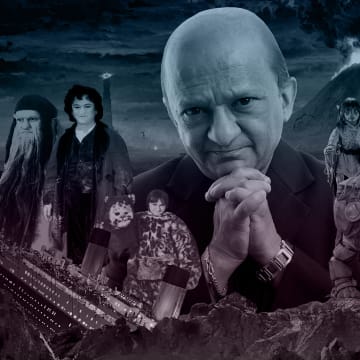
FEATURE · Arts
On a journey from Kenya to Hollywood, Kiran Shah has built one of the most impressive careers in blockbuster history. So why don't you know more about him?

By Thomas Page, CNN
Published 25th September 2020Standing on the deck of a sinking Titanic, Kiran Shah prepared to jump. Fifty feet below, the water waited, cold and indifferent to the moment. It was another long, challenging night, but Shah was a professional; when the call came he did not hesitate.
Cut to Paris and Shah teetering on the Archeveche bridge across the River Seine. The tide had gone out and the drop was higher and the water shallower than planned. He jumped anyway, landing on his back.
Cut again, to Shah in a flimsy canoe whipping down the Kawarau River, New Zealand. As the boat rocked from side to side, he whispered to the actor behind him: "Don't worry about me. If we flip over just save yourself. I can't swim."
You've almost certainly seen Kiran Shah before. You've likely been watching him most of your movie-going life. You also might not recognize him.
Shah is 4 feet 1.7 inches (1.26m) tall and since the late 1970s he's been in demand as the world's smallest stuntman, an actor and scale double. He's played Superman, survived Aliens, died aboard the Titanic, journeyed to Mordor (and back again) and visited a galaxy far, far away six times over. He's worked on three Academy Awards best picture winners and his movies have grossed close to $19 billion.
Yet despite a storied career, Shah has largely slipped past the limelight. But befitting a man around for so many cinematic milestones, he isn't short of a story.
Breaking and entering
Born in Kenya in 1956 to first- and second-generation Indian immigrants, Shah's father owned a shop and his mother embroidered saris. They lived in the Ngara neighborhood of Nairobi, where he would play cricket and football on the dirt road outside his house. "It was a really good life as a young kid," he said via video call.
Cinema was a mainstay. He'd watch Bollywood movies and Westerns on his cousin's TV, then when he moved to Mumbai, India, age 12, he begged an uncle, a grocery supplier to actors and producers, to let him tag along on his rounds. He met Bollywood royalty: Dharmendra, Dara Singh and Hema Malini -- "It was like, 'yeah, I need to be like them,'" he recalled.
Shah was born with a hormone deficiency, meaning by the time he'd decided show business was for him, he'd already stopped growing. "Perfectly formed" is how he describes himself today -- an apt response from a man who has parlayed his unique features and talents into achieving many of his dreams.
After moving to the UK, Shah joined the Red Buddha Theatre Company at 17, learning traditional Japanese mask and mime work. It was during his stint at the troupe that he answered a casting call for a small actor to perform in an upcoming sci-fi movie.
The film was shrouded in mystery, and following an interview he was driven to Elstree Studios outside London to meet director George Lucas. "I went into this prototype R2-D2," Shah remembered. "I was a tad tall, but I still managed to work it."
He received a call offering him the part in "Star Wars," only for Lucas' first choice, Kenny Baker, who had left the production, to walk back on his decision. Casting director Irene Lamb delivered the news but sugared the pill by offering to set up Shah with an agent. Within a month he had an audition and was soon on his first film set being taken under the wing of Oscar winner David Niven.
"Candleshoe," a 1977 Disney crime caper, starred Niven and a young, post-"Taxi Driver" Jodie Foster. Shah was a stand in for one of the cast's young girls, filling in for takes where her face wouldn't be shown and working the long hours a child actor could not.
"David Niven came up to me one day," Shah remembers, "and went, 'Young man ... I can see a twinkle in your eye. You want this; you're hungry to get into this industry. My advice to you is to study everything that is happening on set. Don't be an actor like me and go into your trailer and have a nap in between start-ups. Study everything and you will go far.'"
But it was a different intervention that set Shah's path. Stunt coordinator Bob Anderson (a sword master known for playing Darth Vader in fight scenes in "The Empire Strikes Back" and "Return of the Jedi") encouraged Shah to perform stunts for the character he was standing in for.
"The stunt people took me in very quickly," Shah said. With no formal qualifications he learned on the job: high falls, wire work, fencing and body burns. "A lot of little people didn't want to do what I was doing," he said, and believes never saying no to a stunt distinguished him in the industry. Only today, in his sixties, has he started to reassess that policy.
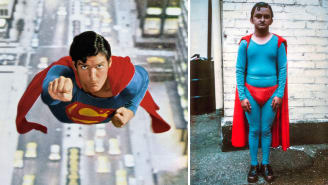
Left: Christopher Reeve as Superman in the 1978 blockbuster. Right: Kiran Shah in costume as Reeve's perspective flying double for the same film. The effects team had Shah wear a mask of Reeve's face when shooting scenes. Credit: Moviestore Collection Ltd/Alamy Stock Photo/Kiran Shah/family collection
Shah was a perspective double for Christopher Reeve in "Superman" (1978), flying on wires against back- and front-projected aerial shots of New York. (The more distant Superman appeared in shot, the smaller the double used. After Shah, the production resorted to puppets, he said.) He performed stunts in "Superman II" (1980) and unwittingly served Indiana Jones poisoned dates in a small acting part in "Raiders of the Lost Ark" (1981). Then he broke into creature work with "The Dark Crystal" (1982), taking on full body performances and stunts for a number of characters in scenes where puppet work by Jim Henson, Frank Oz, et al. wasn't possible.
One day, while shooting "The Dark Crystal," Shah remembers being pulled off set. Lucas was visiting and asked if Shah could test a prototype Ewok costume for his next film; he wanted to know how the creature would move and what its limitations were.
The costume was hot, sweaty and the head misted up. "I did (a) roll ... I couldn't even get to a seated position," he says. "I went (to Lucas), 'can we make it a little bit slimmer?'" Lucas replied in the negative, he recalls.
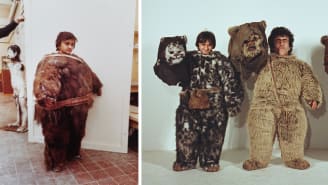
Shah tests a prototype Ewok costume, and right, wearing the finished version for "Return of the Jedi." Credit: courtesy Kiran Shah/family collection/Alamy
But Shah made it work. He entered the Star Wars universe in "Return of the Jedi," playing a robot, an Ewok and performed stunts. After the CGI-packed prequels, the franchise pivoted back to practical creature work in "The Force Awakens" (2015) and he returned, featuring in all five films, sequels and spin-offs.
Creature effects supervisor Neal Scanlan is the brains behind Star Wars' aliens and has worked with Shah since their days creating commercials in the 1990s. He's transformed Shah into everything from space scavengers to private eyes, and refers to his "unique height" and "great artistry."
"Without a great performance the character would neither be convincing nor entertaining to watch," Scanlan told CNN. "Kiran brings both of the above."
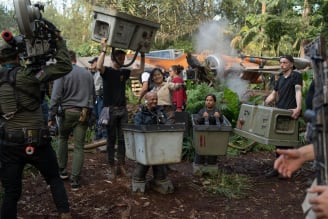
Shah on the set of "Star Wars: The Rise of Skywalker." It was the sixth Star Wars film the actor had performed in; each time as a creature or robot, and sometimes as both. Credit: Courtesy of Lucasfilm Ltd.
"I've been very lucky," Shah reflected. "(By) doing creature work I'm not typecast. I'm not playing me as a little guy -- just a little guy. With creatures I can play anything I want; I can be anything I want."
Behind that statement lies another truth: diverse roles haven't always been available -- particularly when performing in his own skin. "(There were) limited expectations of little people out there," he explains. Did his height sometimes define him in the eyes of scriptwriters and casting directors? "Yeah, it probably would."
New frontiers
Shah credits Terry Gilliam with changing perceptions. The director's 1981 crime caper "Time Bandits" placed a group of short stature actors including Kenny Baker and Malcolm Dixon center stage, while established Hollywood stars including Sean Connery provided support. Their characters were rounded, stereotype-bucking and downright heroic at times. "Little people were shown as actors and not freaks," Shah said.
"My surprise was when I realized no one had given (them) the chance to prove how genuinely talented all of them were," Gilliam recalled in an email to CNN. "They would not have to depend on only working inside tin cans and uncomfortable Ewok costumes."
"The finished film was turned down by all the major studios," he added. "Their argument was that people wouldn't want to watch a bunch of dwarves as the leading men. How wrong we proved them!" (The movie grossed $42 million in the US and Canada on a reported $5 million budget.)
Shah was cast in "Bandits" but ultimately his scenes were cut. The director cast him in "The Adventures of Baron Munchausen" (1988) to make amends. Shah played the assistant to a blind executioner, a pairing of brains and brawn that unfolds like a mini silent comedy of its own.
"I loved working with Kiran," Gilliam said. "He was ballsy, funny and full of ideas, he looked good in a dress and was always refusing to accept limitations. He's a very big personality. He may be taller than me."
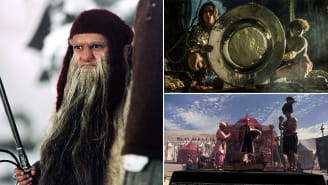
Clockwise from left: Shah as Ginarrbrik, the devious servant of Tilda Swinton's White Witch in "The Chronicles of Narnia: The Lion, the Witch and the Wardrobe" (2005); alongside Tom Cruise in Ridley Scott's "Legend" (1985); as the executioner's assistant in Terry Gilliam's "The Adventures of Baron Munchausen" (1988). Credit: AF Archive/Alamy/Universal Studios/Columbia Pictures Industries
Shah traces a line between Gilliam's groundbreaking movie to the roles he played in Ridley Scott cult fantasy "Legend" (1985) and Andrew Adamson's "The Chronicles of Narnia: The Lion, the Witch and the Wardrobe" (2005) -- meaty little characters with motivations of their own. Much has changed since he began, though he takes no personal credit, citing the advances made by Peter Dinklage ("Game of Thrones") and Warwick Davis ("Harry Potter," "Willow"), among others. "The whole idea is that we could be as good as actors, not just for height," he reflected. "Height is secondary for us."
The professional became personal for Shah when he returned to Kenya in 2013 on an awareness-raising tour, advocating for the rights of short stature people. In Kenya, stigma at home and in the workplace are ongoing issues, he says. On national TV he raised the issue of little people being paid less for their work. "We've got the same brain as everybody else," he lamented.
Ultimately, Shah believes change in the country of his birth will come from within. "It will take time," he said, adding "in Western countries it took years of demanding and pushing for people with disabilit(ies) to be treated equally."
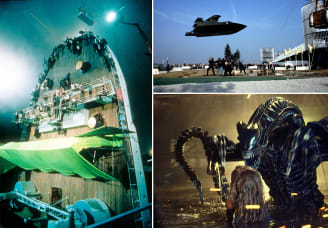
Clockwise from left: The pivoting Titanic set from which Shah and other stunt crew would hang; a stunt sequence from "The World Is Not Enough" (Shah played a child avoiding the boat piloted by James Bond); a still from "Aliens," in which Shah performed stunts for child actor Carrie Henn. Credit: Moviestore Collection Ltd/Alamy Stock Photo/AF Archive/Alamy
Gravity doesn't know inequality: if you jump, you're going to fall. And when acting parts weren't around for Shah, there were always stunts.
His height meant he would frequently perform stunts for child actors -- like Carrie Henn, who played Newt in "Aliens." Shah was overseen by pioneering stuntman Simon Crane for James Cameron's action-horror sequel, a relationship that continued into the '90s when the two cooked up some of Shah's most hair-raising escapades.
"I've tried to drown him on 'Titanic,' hang him from buildings on 'Braveheart,' run him over with a boat on 'The World Is Not Enough' and various others. He still comes back smiling and asking for more," Crane told CNN.
In "Titanic" Shah was hired as part of a 120-person stunt crew working at a giant water tank in Rosarito, Mexico. "Anything undertaken on 'Titanic' was bigger than had been done before," said Crane. "As a stuntman, if you work a lot, you are definitely going to get hurt as the odds are stacked against you. Because of the huge scale of 'Titanic' the odds were definitely stacked against us."
"Kiran jumped from the ship, hung from lifeboats, got hit by numerous dump tanks of water and was in the sinking portion of the ship," he added. "He will try anything."
Director James Cameron was "fun to work with," Shah said, although "he can get angry very quickly as well." However, Shah mostly remembers the director wanting to keep him safe. What Shah considers his most dangerous stunt didn't even make the final cut. Dressed as a young Slovakian boy who Jack (Leonardo DiCaprio) tries to save, he was wiped out by a wall of water breaking into a narrow corridor below deck. But flooding the set with one tank of water proved insufficiently terrifying. In the end more water was added -- 200 tons in total, Crane estimates -- and a dummy used instead. Which is a relief, given Shah can't swim.
It's an alarming thought -- especially considering his plunge into the Seine (for 1998 children's book adaptation "Madeline") -- but Shah takes it in his stride. "Give me a wetsuit and I'll be happy," he said, laughing. "I know I'm going to float up again."
"A pro's pro"
And then there was "The Lord of the Rings," still probably his best-known work to date.
Peter Jackson's ambitious three-part adaptation featured hobbits, a diminutive human-like race from Middle-earth. Although the films would break boundaries with computer-generated imagery, Jackson opted to use forced perspective scale doubles as much as possible in scenes where hobbits interacted with other characters.
Shah was recruited for the trilogy and set to studying the respective actors' movements and mannerisms, learning from DVDs of Elijah Wood (Frodo), Sean Astin (Sam), Billy Boyd (Pippin) and Dominic Monaghan (Merry), and from his previous encounters with the late Ian Holm (Bilbo) ("I worked with Sir Ian in 'Greystoke' so I knew he had a limp"). Usually doubling as the lead in the scene, in one day he could end up playing all five characters.
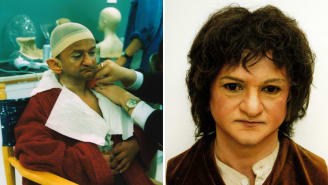
Kiran Shah in the makeup chair and in finished hobbit hair and makeup for "The Lord of the Rings." Credit: courtesy Weta Workshop/New Line Productions
Costumes and weapons were scaled down and the makeup department fitted him with pointy ears and hairy feet prosthetics. But for shots when his face might be seen, Shah wore silicon masks cast from each actor.
"Seeing my still, unmoving, but extremely lifelike face on Kiran for the first time was a mixture of thrilling, as to how much he looked like Frodo as one would imagine, and a little unsettling in the best way," Wood recalled, via email.
"Kiran was a delight," he added, describing him as "the unofficial leader" of the hobbit scale doubles.
Viggo Mortensen played Aragorn and describes Shah as "a pro's pro" and a "true team player." "Although he had already worked in an impressive number of productions by the time we started shooting in Wellington, he never lorded it over any of his less-experienced colleagues," he told CNN.
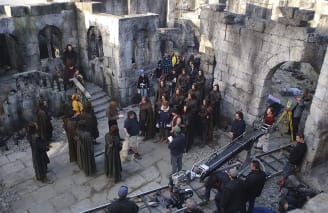
Shah (top left) on the set of "The Lord of the Rings," among the cast and crew receiving direction from Peter Jackson (center). Credit: © 2002 New Line Productions
The trilogy was filmed simultaneously, and for 15 months Shah worked all seasons. He was in demand, sometimes traveling by helicopter as he skipped between units shooting in different parts of the country and changing costume mid-flight. It was not always comfortable -- hobbit feet don't do much to protect from the snowy Southern Alps -- but cast and crew were in it together. "We became a very big family out there," said Shah.
"One of the best things about him was his sense of humor," Mortensen remembered. "That is an important asset on a long, hard shoot like ours was."
"We worked hard and played hard," he added, recalling a game of rugby they played in a rare moment of downtime. "Since Kiran was a stuntman, he could give and take a good tackle, and was a very good wrestler as I recall! He is very quick on his feet ... more than once I ended up doing a face-plant in the tussock grass or the mud when I thought I finally had him in my grasp."
Once again, a hobbit bows to no one.
Yet by the end of the shoot Shah was left with a few battle scars of his own. One day, during a scene for "The Return of the King," Shah was riding with another stunt person on a horse that kept bolting. Shah wanted to try one last take.
"That was one too many, and I came off and fractured my back," he said. "I missed one month of filming and they had to keep me behind because I couldn't fly back (to the UK). I was in a brace and on crutches for about another two or three months."
A decade later, when Peter Jackson returned to Middle-earth with "The Hobbit" trilogy, Shah was back, acting, performing stunts and as scale double for Martin Freeman's Bilbo.
Twenty years after "The Lord of the Rings" shoot, Shah says he's lost contact with most of the cast. Some he's crossed paths with on other jobs. He still has a pair of hobbit feet somewhere about the house, a memento of the films and the endless hours in the makeup chair. He keeps them in a box; the latex is delicate now and liable to crumble if he leaves them out.
Designed to last days but still intact -- cherished, even -- they're a fitting totem. "It's a connecting bond, though, that we were all hobbits together," said Wood; "an honor that we'll never take for granted."
Shah isn't one for nostalgia, always occupied with the next job. The coronavirus pandemic has forced a pause, however. A couple of projects -- neither of which he can discuss -- have ground to a halt and during lockdown he barely left his house in Hounslow, West London. In his newfound spare time he's writing poetry ("beautiful," Scanlan says) to be published in an anthology with all proceeds going to Great Ormond Street Hospital, the London children's hospital that treated his hormone deficiency as a boy.
He bats away notions of legacy. Often it takes other people to remind him of his films. When he does reflect, it feels good to have been somewhere in the frame at so many pivotal moments in movie history. But otherwise Shah doesn't think about it.
"I'm like, 'yeah, I was there.' Maybe I was the right person at the right time, every time."
A nightmare made good
There are countless stories from Shah's TV career, appearances in music videos from Spandau Ballet to Aphex Twin, and a riotous streak of commercials, that will have to wait. When he finally made his Bollywood debut. The time he played Miss Piggy.
From watching Westerns on a TV in Nairobi in the 1960s, Shah has come a long way. And after a career behind a mask, under a wig, in the throng, seldom seen for who he is and, less frequently still, heard, it's beyond time for his close-up.
But although Shah has never particularly courted fame, he's aware it has its uses.
In the late '80s Shah was in New York, hunting for an agent. He'd recently had a small part in "Gothic" by Ken Russell, in which he was cast as a demon terrorizing Mary Godwin, played by Natasha Richardson. The job was only a day's work, but the image of him crouched atop Richardson -- an homage to Henry Fuseli's painting "The Nightmare" -- was splashed across marketing art. It was his first poster.
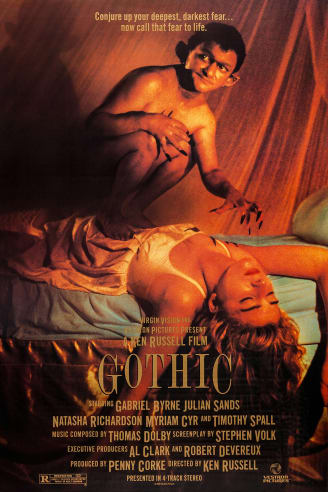
US poster for "Gothic" by British director Ken Russell. Credit: Vestron Pictures/Courtesy Everett Collection
Shah found himself on 42nd Street after dark. It was still the bad old days and he'd been warned not to linger. No taxis were stopping, and some strangers took an unhealthy interest. Mid-mugging, "one guy looked at the wall and did a double take. There was a poster of me on Natasha Richardson's chest. He went, 'Is that you, dude?' I went 'yep,' and he goes, 'Oh God, we've got a star here!'"
"They got me a cab and threatened the driver, saying if he took money from me, they'd harm him," he recalled. When the driver realized the actor had left his keys on the back seat, he even returned to drop them off. "(Russell) saved my life that day," Shah said, catching his breath between laughs.
"You know those posters were banned in London?" he added. In the UK, Shah was replaced with his own silhouette. The question hangs in the air and the spotlight drifts away.
Illustration by Gabrielle Smith.
Images: Kiran Shah family collection/Lucasfilm Ltd./Alamy/AF Archive/Universal Studios/Moviestore Collection Ltd/Weta Workshop/New Line Productions/Vestron Pictures/Everett Collection/Paramount Pictures/HCK Photography

No comments:
Post a Comment